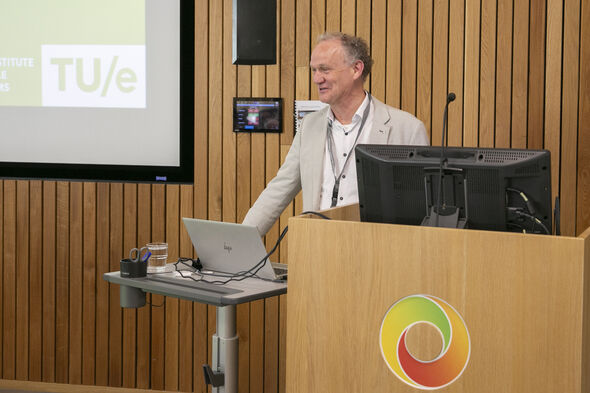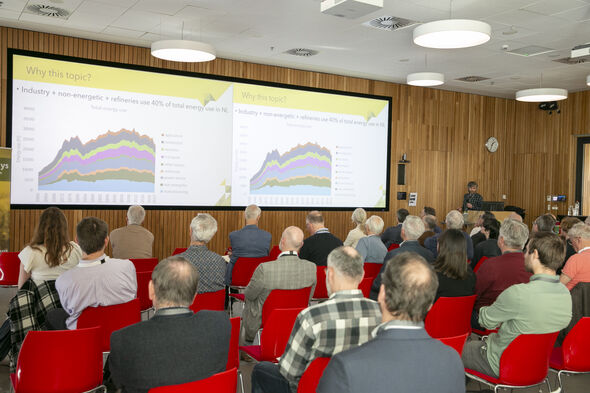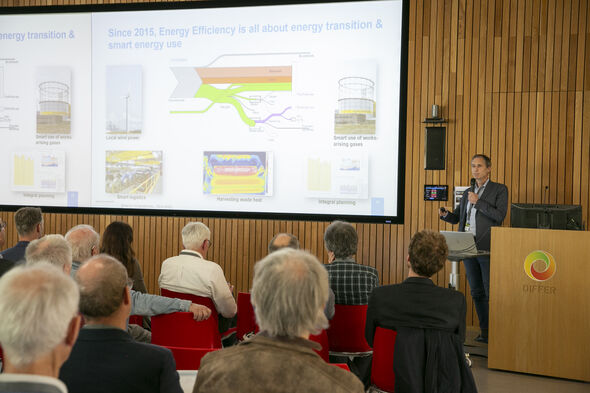Making the industry carbon neutral remains a tough challenge
Industry is responsible for nearly a third of our CO2 emissions. Significant steps need to be taken toward the sector's sustainability to continue the energy transition. What is required for this, what are the biggest obstacles, and where are the opportunities? These questions took center stage during EnergyDays on the TU/e campus.
While former president of the Executive Board Robert-Jan Smits celebrates his farewell at the Auditorium, dozens of visitors gather Thursday afternoon at the DIFFER building on the other side of campus. They are here for EnergyDays, a recurring event hosted by EIRES, the institute for renewable energy. This year, the focus is on the big challenge: how do we make industrial heat CO2-neutral?
Richard van den Sanden, scientific director of EIRES, opens the event and highlights an important milestone: the institute's five-year anniversary. He also explains the role of EIRES as an accelerator of the energy transition and as a bridge-builder between various organizations and areas of expertise. He mentions some tangible successes of EIRES, such as the startups Carbyon and RIFT, which focus on CO2 capture and clean fuels, and the megabattery on the TU/e campus, which helps to address local grid congestion.
Urgency
The urgency of the energy transition is emphasized by Herbert Zondag, researcher in thermal energy storage at TU/e and TNO. “Industry is responsible for over thirty percent of total CO2 emissions,” he says. The graphs he presents illustrate the scale of the problem. The energy demand from industry, refineries, and the chemical sector remains high and is unlikely to decrease in the near future. Together, these sectors account for forty percent of total energy consumption in the Netherlands.
Zondag points out that the decarbonization of industry is crucial to meeting climate goals. “In 25 years from now, industry must be CO2-neutral,” he says. He notes that the sector is currently under great pressure due to a highly competitive market, making it even more challenging to make the necessary sustainability investments. According to Zondag, urgent policy action is needed at both the national and European levels to accelerate the transition. He also sees a key opportunity in the reuse of waste heat. “If you can use waste heat for your own processes or sell it to other users, you make your processes more efficient and reduce your energy consumption,” he suggests.
Jenga
Next, Tim Peeters from Tata Steel takes the floor, working in Research & Development. He is a fitting speaker from industry, as Zondag's charts show that Tata Steel is one of the largest emitters within the Dutch industrial sector. However, Peeters brings mostly good news: the company is making significant strides toward cleaner steel production. Tata Steel is working on transitioning from coal to more sustainable energy sources and is building a DRI plant (Direct Reduced Iron), which turns iron ore into iron using gas instead of coal, and an electric furnace. These installations are expected to be operational by 2030, after which some of the existing blast furnaces will be shut down. With these measures, Tata Steel aims to significantly reduce its CO2 emissions.
At the same time, Tata Steel is working on improving energy efficiency by adjusting production processes, using energy smartly, and focusing on circularity. Peeters mentions several concrete examples: using local wind energy, smart logistics, utilizing waste heat, and efficiently reusing process gases. “We are trying to hit multiple targets; it’s about more than just CO2 reduction.”
However, Tata Steel faces a lot of criticism. The plans for a more sustainable steel production have been around for some time, but why has so little been achieved so far? Peeters frequently hears this question, and he acknowledges it. According to him, it’s not just about decarbonization but about a complete overhaul of the entire production process, where everything is interconnected. “You can’t change everything at once without disrupting the system,” he explains. He compares it to a Jenga tower: “If you take out some blocks just like that, the whole tower collapses. That's why we are replacing the old factories step by step with new ones.”
A complex transition
The sustainability of industry proves to be no easy task. In addition to technological innovations, strong policy guidance is necessary to support companies in the energy transition. The presentations during EnergyDays show that steps are being taken, but also that there is still much work to be done. In the coming years, it will become clear how quickly and effectively the industry can make this transformation.





Discussion